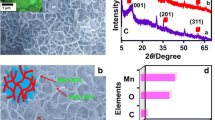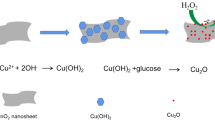Abstract
In this study, carbon quantum dots (CQDs) were first synthesized using a hydrothermal method, and then, Au@SiO2 core-shell nanomaterials were synthesized using layer-by-layer assembly. CQDs were adsorbed on the surface of Au@SiO2 nanoparticles through self-assembly to form Au@SiO2/CQDs nanocomposite materials. Transmission electron microscopy and X-ray diffraction were used to characterize the size, shape, element composition, and structure of nanocomposites; ultraviolet-visible absorption spectroscopy and fluorescence spectroscopy were used to analyze the optical properties of nanocomposites. The results show that Au@SiO2/CQD nanomaterials have a core-shell structure with good morphology and exhibit excellent luminescence characteristics. The electrochemical performance of nanocomposites was characterized using electrochemical means, and a hydrogen peroxide sensor was constructed for the sensitive detection of hydrogen peroxide, thus realizing the rapid and sensitive detection of hydrogen peroxide at levels as low as 0.2 mM. The electrode GCE modified with Au@SiO2/CQDs exhibits good selectivity and stability in the detection of hydrogen peroxide.












Similar content being viewed by others
Data availability
The data that support the findings of this study are openly available.
References
Aparicio-Martínez E, Ibarra A, Estrada-Moreno IA et al (2019) Flexible electrochemical sensor based on laser scribed graphene/Ag nanoparticles for non-enzymatic hydrogen peroxide detection. Sens Actuators B Chem 301:127101
Thanh TD, Balamurugan J, Lee SH et al (2016) Novel porous gold-palladium nanoalloy network-supported graphene as an advanced catalyst for non-enzymatic hydrogen peroxide sensing. Biosens Bioelectron 85:669–678
Li H, Yang J, Deng Q et al (2018) Au nanoparticle@ silica@ europium coordination polymer nanocomposites for enhanced fluorescence and more sensitive monitoring reactive oxygen species. Sci China Mater 61(3):401–408
Zhang MR, Chen XQ, Pan GB (2017) Electrosynthesis of gold nanoparticles/porous GaN electrode for non-enzymatic hydrogen peroxide detection. Sens Actuators B: Chem 240:142–147
Tran HV, Huynh CD, Tran HV et al (2016) Cyclic voltammetry, square wave voltammetry, electrochemical impedance spectroscopy and colorimetric method for hydrogen peroxide detection based on chitosan/silver nanocomposite. Arab J Chem:1–7
Tran HV, Trinh AX, Huynh CDF et al (2016) Hydrothermal synthesis of silver/chitosan nanocomposite and application in the electrochemical detection of hydrogen peroxide. Sens Lett 14(1):32–38
Yuan T, Meng T, He P et al (2019) Carbon quantum dots: an emerging material for optoelectronic applications. J Mater Chem C 7(23):6820–6835
Chan KK, Yap SHK, Yong KT (2018) Biogreen synthesis of carbon dots for biotechnology and nanomedicine applications. Nano-Micro Lett 10(4):1–46
Amjadi M, Hallaj T, Asadollahi H et al (2017) Facile synthesis of carbon quantum dot/silver nanocomposite and its application for colorimetric detection of methimazole. Sens Actuators B: Chem 244:425–432
Liu H, Yang J, Li Z et al (2019) Hydrogen-bond-induced emission of carbon dots for wash-free nucleus imaging. Anal Chem 91(14):9259–9265
Tran HV, Le TA, Giang BL et al (2019) Silver nanoparticles on graphene quantum dots as nanozyme for efficient H2O2 reduction in a glucose biosensor. Mater Res Express 6:115403
Jiang X, Li BQ, Qu X et al (2019) Multilayered dual functional SiO2@ Au@ SiO2@ QD nanoparticles for simultaneous intracellular heating and temperature measurement. Langmuir 35(19):6367–6378
Wang H, Ming S, Zhang L et al (2018) A simple strategy to achieve shape control of Au-Cu2−xS colloidal heterostructured nanocrystals and their preliminary use in organic photovoltaics. Nanoscale 10(25):11745–11749
Yang TQ, Peng B, Shan BQ et al (2020) Origin of the photoluminescence of metal nanoclusters: from metal-centered emission to ligand-centered emission. Nanomaterials 10(2):261
Zhang H, Li Y, Long X et al (2020) Self-assembled metamaterial perfect absorbers at visible wavelengths using core–shell Au@ SiO 2 meta-atoms. J Mater Chem C 8(37):12876–12885
Chen D, Shi J, Shen H (2020) High-dispersed catalysts of core–shell structured Au@ SiO2 for formaldehyde catalytic oxidation. Chem Eng J 385:123887
Montaño-Priede JL, Coelho JP, Guerrero-Martínez A et al (2017) Fabrication of monodispersed Au@ SiO2 nanoparticles with highly stable silica layers by ultrasound-assisted stober method. J Phys Chem C 121(17):9543–9551
Sakthisabarimoorthi A, Dhas SAMB, Jose M (2020) Study on optical nonlinearity of Au@ SiO2 composite nanoparticles towards photonic applications. Mater Chem Phys 240:122154
Li X, Xu Y, Chen Y et al (2019) Dual enhanced electrochemiluminescence of aminated Au@ SiO2/CdS quantum dot superstructures: electromagnetic field enhancement and chemical enhancement. ACS Appl Mater Interfaces 11(4):4488–4499
Li SH, Weng B, Lu KQ et al (2018) Improving the efficiency of carbon quantum dots as a visible light photosensitizer by polyamine interfacial modification. Acta Phys Chim Sin 34:708–718
Huang J, Li L, Chen J et al (2020) Broad spectrum response flower spherical-like composites CQDs@ CdIn2S4/CdS modified by CQDs with up-conversion property for photocatalytic degradation and water splitting. Int J Hydrogen Energy 45(3):1822–1836
Wijaya H, Darwan D, Lim KRG et al (2019) Large-Stokes-Shifted Infrared-Emitting InAs–In (Zn) P–ZnSe–ZnS Giant-Shell Quantum Dots by One-Pot Continuous-Injection Synthesis. Chem Mater 31(6):2019–2026
Riaz R, Ali M, Maiyalagan T et al (2019) Dye-sensitized solar cell (DSSC) coated with energy down shift layer of nitrogen-doped carbon quantum dots (N-CQDs) for enhanced current density and stability. Appl Surf Sci 483:425–431
Wang W, Ji Y, Zhang Y et al (2016) Green preparation of Au nanoparticles for electrochemical detection of H2O2. J Semiconduct 37(1):013003
Wen S, Miao X, Fan GC et al (2019) Aptamer-Conjugated Au Nanocage/SiO2 Core–shell bifunctional nanoprobes with high stability and biocompatibility for cellular SERS imaging and near-infrared photothermal therapy. ACS Sens 4(2):301–308
Cao N, Zhao F, Zeng B (2020) A novel self-enhanced electrochemiluminescence sensor based on PEI-CdS/Au@ SiO2@ RuDS and molecularly imprinted polymer for the highly sensitive detection of creatinine. Sens Actuators B: Chem 306:127591
Liu M,Deng J,Chen Q et al (2013) Sensitive detection of rutin with novel ferrocene benzyne derivative modified electrodes. Biosens Bioelectron 41:275 – 281
Wang X, Wang Y, Shan Y et al (2018) A novel and sensitive electrogenerated chemiluminescence biosensor for detection of p16INK4a gene based on the functional paste-like nanofibers composites-modified screen-printed carbon electrode. J Electroanal Chem 823:368–377
Dong W, Ren Y, Zhang Y et al (2017) Synthesis of Pb nanowires-Au nanoparticles nanostructure decorated with reduced graphene oxide for electrochemical sensing. Talanta 165:604–611
Lu YY, Li NL, Jia LP et al (2016) The synthesis of Ag@ CQDs composite and its electrochemiluminescence application for the highly selective and sensitive detection of chloride. J Electroanal Chem 781:114–119
Wang M, Yin H, Zhou Y et al (2019) A novel photoelectrochemical biosensor for the sensitive detection of dual microRNAs using molybdenum carbide nanotubes as nanocarriers and energy transfer between CQDs and AuNPs. Chem Eng J 365:351–357
Zhu P, Zhao Y (2019) Cyclic voltammetry measurements of electroactive surface area of porous nickel: peak current and peak charge methods and diffusion layer effect. Mater Chem Phys 233:60–67
Yang MH, Kim DS, Yoon JH et al (2016) Nanopillar films with polyoxometalate-doped polyaniline for electrochemical detection of hydrogen peroxide. Analyst 141(4):1319–1324
Funding
This work was financially supported by the National Natural Science Foundation of China (51702006, 22002002), Shaanxi provincial science and technology planning project (2018JQ2056), the Youth Science and Technology New Star Plan of Shaanxi Province] grant number (2021KJXX-50), the Phytochemistry Key Laboratory of Shaanxi Province (NO.18JS007), and the Natural Science Foundation of Shaanxi Province (2023JCYB120).
Author information
Authors and Affiliations
Contributions
Li H and Wu L proposed the research and guided the project. Deng C and Huang F designed and performed the experiments. Lei H and Ren Li analyzed and discussed the experimental results, Zhang H prepared Figs. 8, 9, and 10; Zhao W and Zhao Q were responsible for stability and selectivity experiments. Li H and Deng C drafted the manuscript. All the authors reviewed and approved the manuscript.
Corresponding authors
Ethics declarations
Ethics approval and consent to participate
Not applicable.
Competing interests
The authors declare no competing interests.
Additional information
Publisher’s Note
Springer Nature remains neutral with regard to jurisdictional claims in published maps and institutional affiliations.
Rights and permissions
Springer Nature or its licensor (e.g. a society or other partner) holds exclusive rights to this article under a publishing agreement with the author(s) or other rightsholder(s); author self-archiving of the accepted manuscript version of this article is solely governed by the terms of such publishing agreement and applicable law.
About this article
Cite this article
Li, H., Wu, L., Lei, H. et al. Electrochemical sensing based on Au particle@SiO2@CQDs nanocomposites. Gold Bull 56, 145–155 (2023). https://doi.org/10.1007/s13404-023-00329-z
Received:
Accepted:
Published:
Issue Date:
DOI: https://doi.org/10.1007/s13404-023-00329-z




